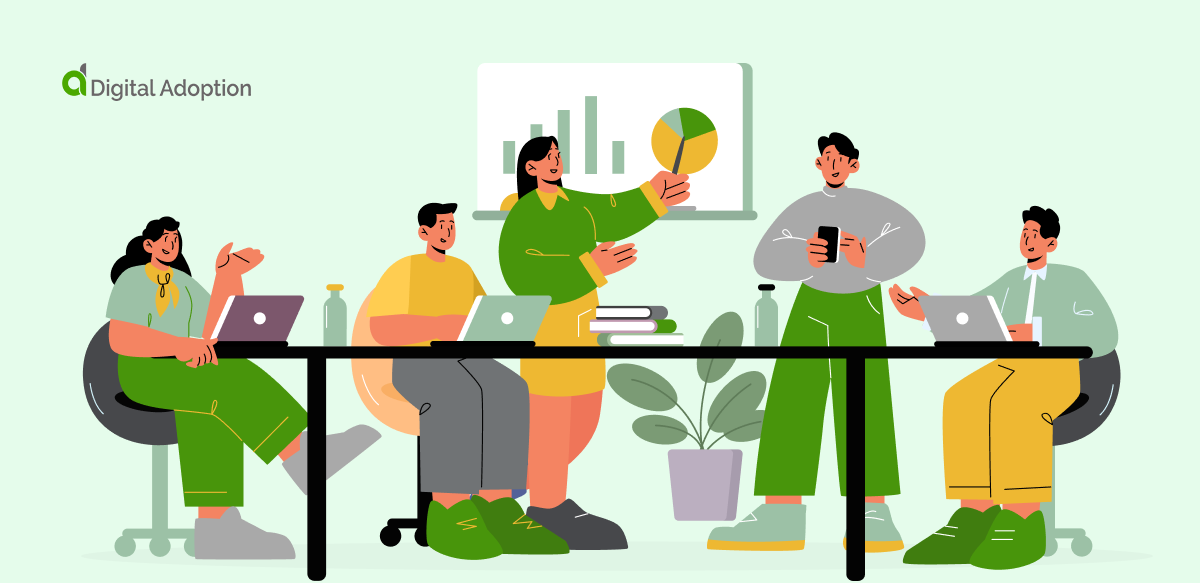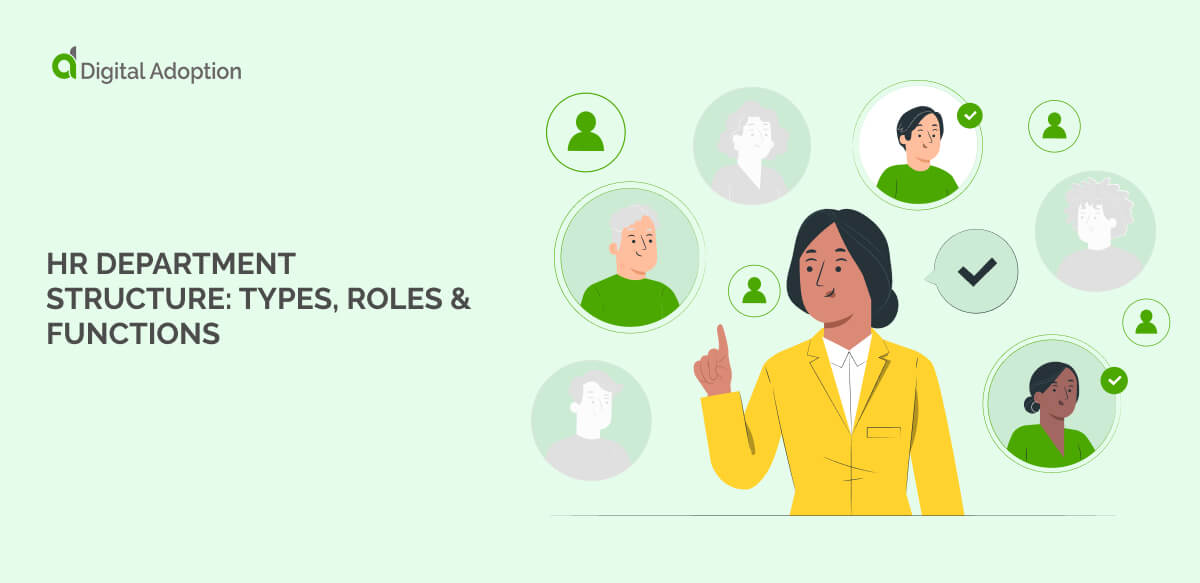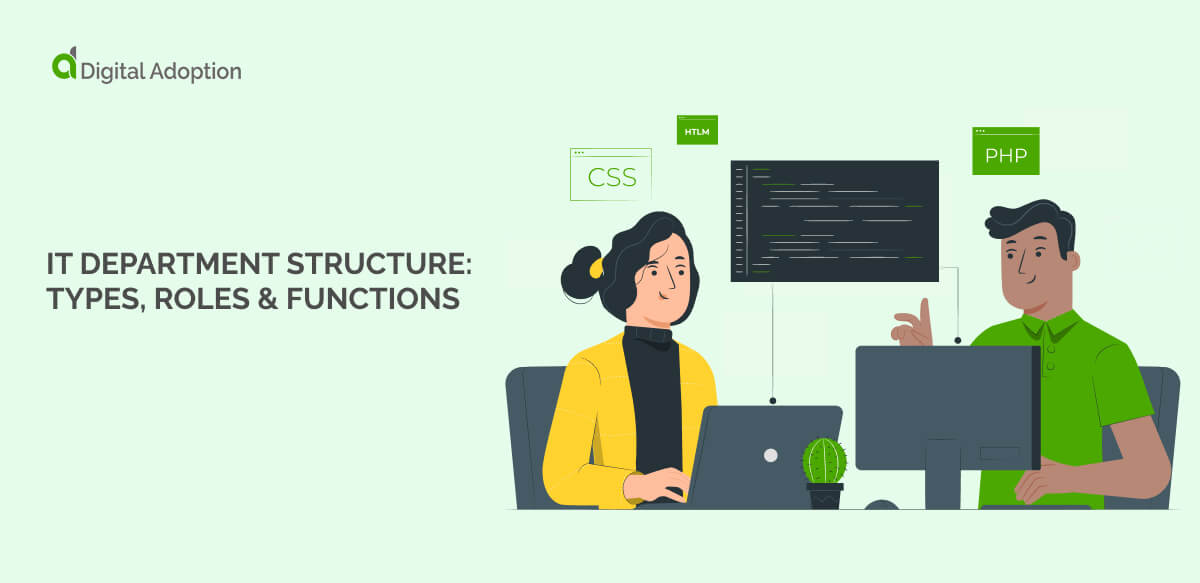As technological progress shapes the world, business leaders often interchangeably throw around terms like digital adoption and digital transformation. While the processes are closely related, it’s important to understand the difference between the two.
Digital transformation (DX) describes how a business uses technology to achieve growth. Digital adoption (DA) is a part of the digital transformation process. We’ll look at the key differences and explain how the processes intersect to transform a company. We will also explore how businesses can achieve digital maturity, embrace digital disruption and why a holistic approach to digital transformation is crucial.
- What Is Digital Adoption (DA)?
- What Is Digital Transformation (DX)?
- What Are The Qualities Of A Digitally Mature Company?
- The Holistic Approach To Digital Transformation
- How Does Digital Transformation Intersect With Digital Adoption?
- What is Digital Disruption?
- What Causes Digital Disruption & Digital Transformation?
- Why is Digital Transformation Important?
What Is Digital Adoption (DA)?
Digital adoption (DA) is how a company learns to get the most out of new technology. It’s about maximizing value from software investments, providing more options for customers through new digital tools, and increasing employee productivity.
Digital adoption is less about technology and more about creating a digital-friendly company. A successful digital adoption strategy leads to a new status quo. An organization aims to address employee attitudes to digital tools through comprehensive training materials. Digital adoption platforms (DAPs) offer a great solution to the problem of company-wide training by streamlining the process.
Technological progress shows no sign of slowing down, and customer demands constantly evolve. The digital adoption process makes a company more adaptable and prepared for anything in a highly digital world.
What Is Digital Transformation (DX)?
Digital transformation (DX) refers to the encompassing process of using digital technology to improve a business. A successful digital transformation strategy focuses on enhancing processes, increasing productivity, and offering better products to customers through digitalization. Digital adoption is a crucial element of this process.
Business leaders believe that more technology equals more efficiency, and they fail to understand how to get the most out of their tools. It’s like a person who buys a lot of books to convince themselves that they’re an avid reader when in reality, they haven’t finished a book in months.
Technology can transform a workplace, but how you use that technology is more important. Digital transformation includes data, technology, and business processes. It also serves as a roadmap outlining digital tools that aim to improve each of these areas. Business leaders target specific areas of the organization that would benefit from digitalization.
For example, companies have shifted to an automated screening system to filter through potential candidates, streamlining the recruitment process. This method is more efficient and cost-effective over time. This is just one example of how a business implements a digital transformation strategy to improve a process.
What Are The Qualities Of A Digitally Mature Company?
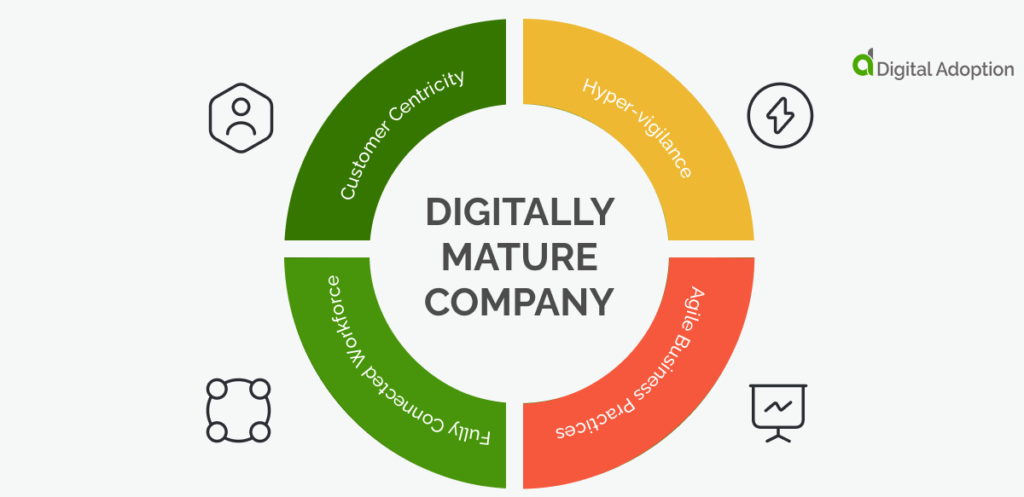
Digital maturity measures a company’s ability to get the most value from technology investments for stakeholders, employees, and customers. Technology can boost user productivity, increase business value and lead to better business outcomes. To become digitally mature, a business must prioritize the following qualities.
Customer Centricity
Customer centricity is the core of all digital transformation initiatives. It’s about making digital technology accessible and worthwhile for customers. Digitally mature companies create more space for digital innovation, meaning they can provide better products and services to customers. Also, improving internal business processes adds value that trickles down to the customer experience.
Hyper-vigilance
A defining trait of a digitally mature company is hyper-vigilance. Digital technologies lead to more efficiency across the board and make an organization stronger. As a result, they’re more responsive to disruptions. Think of digital maturity as a fleet of soldiers defending a castle, staying vigilant for threats, ready to strike at a moment’s notice.
Agile Business Practices
Digital transformation leads to innovation. An organization can experiment with digital tools to find new ways of doing things and offer new services to customers. A business becomes agile, able to bend to the demands of a shifting marketplace to stay ahead of the competition.
Fully Connected Workforce
Finally, widespread digital adoption leads to an empowered workforce that supports the transformation process and welcomes its benefits. Employees can feel left behind during software deployment in a business setting. New technology can feel alien to a workforce that is more familiar with traditional systems, especially if they aren’t supported during the implementation phase.
The Holistic Approach To Digital Transformation
During its digital transformation process, a company must move as one. Employees can begin to feel out of the loop very quickly when processes are changing around them. If digital tools are replacing old systems, employees need to feel supported in learning new technologies.
True digital adoption is an ongoing process, so continuous training is required to keep everyone energized. It’s also important to maintain transparency from the top down. This approach to supporting individuals to create organizational change, known as change management, can make all the difference to your digital transformation efforts. Change management is crucial to maximizing your training efforts to achieve positive ROI on all new tech that’s introduced.
Think of digital transformation as a construction project, like paving a new road. No one expects to drive their car down an unfinished road. In the same way, without a holistic approach, a business will struggle to achieve meaningful organizational change.
How Does Digital Transformation Intersect With Digital Adoption?
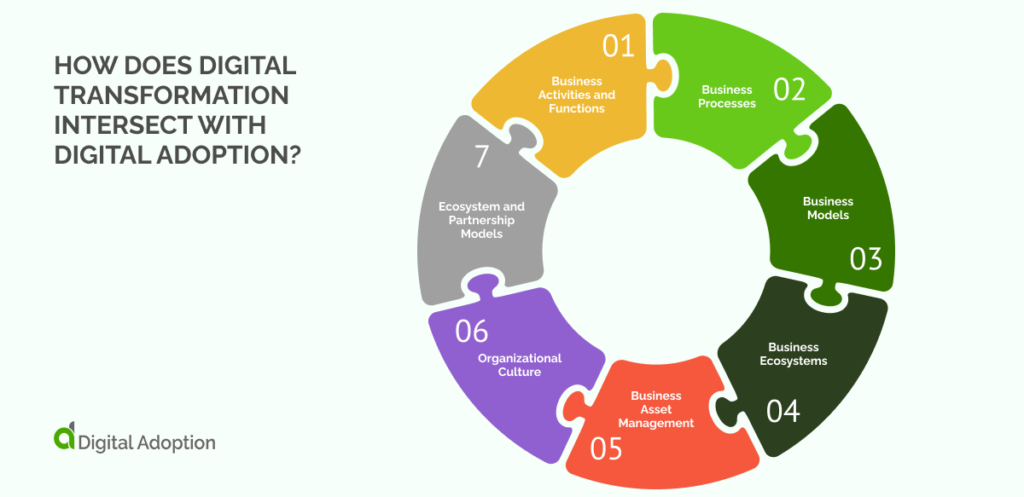
Understanding the difference between digital transformation and digital adoption is key to getting the most out of new technologies.
Digital transformation refers to a change from manual systems to digital ones. It’s about maximizing technology investments in a targeted manner. A company’s transformation relies on exploiting growth opportunities and increasing business efficiency. However, the process doesn’t have an end-point, and it’s better to think of it as an ongoing strategy to keep up with technological progress.
Digital adoption is a component of the transformation that focuses on the human elements of a business. Digital adoption platforms make new technology easier for users and encourage a culture of innovation.
Digital adoption is how a company becomes a chameleon, able to adapt quickly to a changing environment. It’s a way to stay vigilant to current thinking and trends to outpace the competition. Digital adoption isn’t just a survival strategy. It’s how modern businesses thrive in a digitalized world.
Before embarking on a digital adoption strategy, it’s important to know how digital transformation affects seven key areas.
- Business Activities and Functions
New technology can change a business’s day-to-day operations, including marketing, customer service, and human resources. Digital transformation targets these areas to make them more efficient.
- Business Processes
Digital transformation also aims to optimize and automate business processes with new software. These can be customer-facing processes or internal ones. Either way, the results trickle down to the customer experience.
- Business Models
Digital adoption sometimes requires a whole new business strategy. Digital transformation leads to adaptability. It’s not uncommon for a business to change drastically after discovering a more profitable business model.
- Business Ecosystems
Digital transformation can expand a business ecosystem. Technology helps connect networks of companies with similar backgrounds and encourages them to collaborate. It’s also easier for a business to keep up with evolving stakeholder demands.
- Business Asset Management
Business assets such as information become more valuable through digital transformation. A business can grow and offer better customer experiences by learning more about its customers. After all, customer needs are the core of every business strategy and dictate the direction of digital initiatives.
- Organizational Culture
Through digital transformation, a business develops an organizational culture, making it easier to achieve its goals. Competency improves across the board, and the company becomes future-proof, more adaptable, and functions more effectively.
- Ecosystem and Partnership Models
Digital adoption opens the door to a new ecosystem and partnership models. A company becomes a better collaborator with partner companies and extends its reach within the industry. A whole new horizon of benefits awaits those who achieve digital transformation success.
What is Digital Disruption?
Disruption of any kind sounds like a terrifying prospect for any ambitious company, but it can have a positive effect. The reality is that disruptions are inevitable, and it’s pointless trying to fight them.
New digital technologies often dictate trends and disrupt common business practices. Companies often miss out on capitalizing on these disruptions because they aren’t prepared. Digital adoption doesn’t grant company fortune-telling abilities. Instead, it determines an organization’s ability to respond to changes quickly.
Anticipating and acting on emerging trends drives digital adoption. New digital processes are more efficient and lead to a new level of success that wasn’t possible before. The best approach is to flow with the tide and not get swept away trying to resist it.
What Causes Digital Disruption & Digital Transformation?
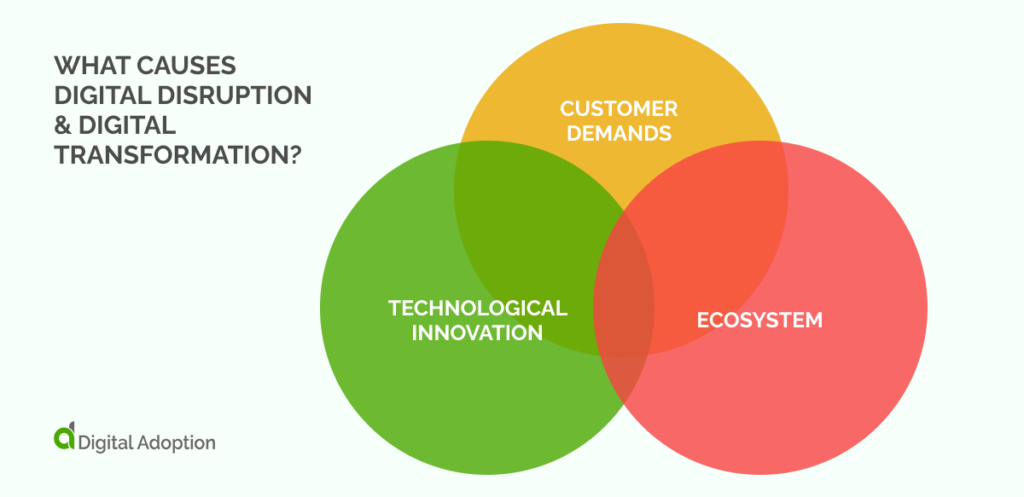
As more people use digital devices like mobile phones, change becomes more likely. Gartner predicts that these 12 technology trends in 2022 alone will affect future business processes.
There are three primary sources of technological disruption that often lead businesses to adopt a transformation strategy. Companies that stay vigilant sometimes even become the disruptors themselves by introducing digital technology to the market.
- Technological Innovation
The most apparent cause of disruption is the introduction of new technology. A great example is the introduction of digital cameras, disrupting the sale of film photography and photo processing. Brands like Canon and Sony overtook the market because they capitalized on the rise in gadget culture and shifted their consumer base to include more men.
- Customer Demands
As technology becomes easier to use, consumer behavior changes. A new app or online service can dominate an existing market very quickly. The rise in on-demand taxi rides in recent years is a clear example. While many traditional taxi services failed to change to customer demands, Uber led the way.
- Ecosystem
Changes in the immediate ecosystem can shake up established industry standards. Cryptocurrency is on the radar of many experts as a force for change in the business world. Trends indicate large corporations and even governments shifting to adopt crypto, potentially causing the largest ecosystem disruption in recent memory. Why is Digital Transformation Important?
Why is Digital Transformation Important?
Understanding the difference between digital adoption and digital transformation is crucial to creating a winning strategy. It’s a great start when business leaders transform a business through digitalization, but the work doesn’t stop there. That’s where digital adoption comes in. When leaders transform a business stuck in the past into a digitalized and empowered business.
Digital adoption helps a business become more agile and better equipped to deal with challenges. We’ve all experienced these challenges firsthand during the COVID-19 pandemic. The past two years created several challenges for organizations of every size. Smaller companies watched their customers decrease as people relied on digital shopping methods.
The pandemic’s lasting effects caused CMOs to drastically rethink their marketing strategies last year. Gartner’s recommendation is to focus on the future by reaching new markets.
In conclusion, it’s clear that the future is digital, and any company that hopes to be a part of that future needs to prioritize digital transformation.

